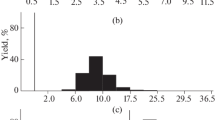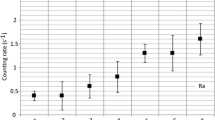Abstract
An improved and novel sample preparation method for 226Ra determination in liquid samples by isotope dilution inductively coupled plasma sector field mass spectrometry using laboratory-prepared 228Ra tracer has been developed. The procedure involves a selective preconcentration achieved by applying laboratory-prepared MnO2 resin followed by cation exchange chromatographic separation. In order to completely eliminate possible molecular interferences, medium mass resolution (R = 4,000) combined with chemical separation was found to be a good compromise that enhanced the reliability of the method. The detection limit of 0.084 fg g−1 (3.1 mBq kg−1) achieved is comparable to that of the emanation method or alpha spectrometry and is suitable for low-level environmental measurements. The chemical recovery of the sample preparation method ranged from 72 to 94%. The proposed method enables a rapid, accurate and less labor-intensive approach to routine environmental 226Ra determination than the radioanalytical techniques conventionally applied.




Similar content being viewed by others
References
Becker JS (2005) Int J Mass Spectrom 242:183–195
United Nations Scientific Committee on the Effects of Atomic Radiation (1982) Ionizing radiation: sources and biological effects. United Nations, New York
US EPA (2007) Website. http://www.epa.gov. Cited 6th June 2007
Foster DA, Staubwasser M, Henderson GM (2004) Mar Chem 87:59–71
Windom HL, Moore WS, Niencheski LFH, Jahrike RA (2006) Mar Chem 102:252–266
Paschoa AS (1997) Appl Radiat Isotopes 48:1391–1396
Kovacs T, Bodrogi E, Dombovari P, Somlai J, Nemeth C, Capote A, Tarjan S (2004) Radiat Prot Dosim 108:175–181
Kim G, Burnett WC, Dulaiova H, Swarzenski PW, Moore WS (2001) Environ Sci Technol 35:4680–4683
Morvan K, Andres Y, Mokili B, Abbe JC (2001) Anal Chem 73:4218–4224
Surbeck H (2000) Appl Radiat Isotopes 53:97–100
Ghaleb B, Pons-Branchu E, Deschamps P (2004) J Anal Atom Spectrom 19:906–910
Cohen AS, Onions RK (1991) Anal Chem 63:2705–2708
Joannon S, Pin C (2001) J Anal Atom Spectrom 16:32–37
Zoriy MV, Varga Z, Pickhardt C, Ostapczuk P, Hille R, Halicz L, Segal I, Becker JS (2005) J Environ Monitor 7:514–518
Lariviere D, Epov VN, Reiber KM, Cornett RJ, Evans RD (2005) Anal Chim Acta 528:175–182
Lariviere D, Epov VN, Evans RD, Cornett RJ (2003) J Anal Atom Spectrom 18:338–343
Maggi L, Caramella VC, Ganzerli MTV (2001) Analyst 126:399–404
Varga Z (2007) Appl Radiat Isotopes, in press, DOI 10.1016/j.apradiso.2007.05.001
Heumann KG, Gallus SM, Rädlinger G, Vogl J (1998) J Anal Atom Spectrom 13:1001–1008
Lide DR (ed)(2005) CRC Handbook of chemistry and physics, internet version. CRC Press, Boca Raton, FL
Sohrabi M, Beitollahi MM, Hafezi S, Asefi M, Bolourchi M (1999) Health Phys 77:150–153
Almeida RMR, Lauria DC, Ferreira AC, Sracek O (2004) J Environ Radioactiv 73:323–334
Acknowledgements
Part of this study was carried out within the Technical Cooperation on Radioecological Monitoring of Azerbaijan Sector of Caspian Sea with the International Atomic Energy Agency (IAEA), and it was financially supported by the Hungarian Atomic Energy Authority (OAH-ANI-ABA-05/06).
Author information
Authors and Affiliations
Corresponding author
Rights and permissions
About this article
Cite this article
Varga, Z. Ultratrace-level radium-226 determination in seawater samples by isotope dilution inductively coupled plasma mass spectrometry. Anal Bioanal Chem 390, 511–519 (2008). https://doi.org/10.1007/s00216-007-1394-9
Received:
Revised:
Accepted:
Published:
Issue Date:
DOI: https://doi.org/10.1007/s00216-007-1394-9




